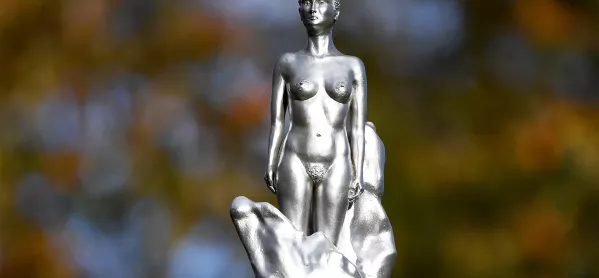- Home
- Mary Wollstonecraft was more than a pair of knockers
Mary Wollstonecraft was more than a pair of knockers

Two-and-a-quarter centuries after her death, Mary Wollstonecraft has been honoured with a statue.
Great news, eh? Currently, more than 90 per cent of statues in London are of men, so this goes a little way towards redressing the balance. And it’s Mary, for heaven’s sake: author of A Vindication of the Rights of Women - honey, you had me at “vindication” - and the mother of feminism. She’s immortalised in silvered bronze, emerging from a swirl of female forms to stand, proudly, on Newington Green. Naked.
I want to be OK with this. I want to nod approvingly and agree that artist Maggi Hambling - a formidable free thinker in her own right - has produced a provocative work of art, representing Wollstonecraft as everywoman, freed from the restrictions of social niceties and clothing that pin her down to a time and place and class.
But I’m really not OK with it. She’s not everywoman - Wollstonecraft’s an individual who boldly defied her time, place and class. Her nakedness at the very least strips her of her identity. And far from encouraging, in Hambling’s words, “a visual conversation with the obstacles Wollstonecraft overcame”, it reduces a groundbreaking philosopher to her bodily parts.
A post-feminist minefield
Blimey. It’s a post-feminist minefield. There’s no shame in the female body; Wollstonecraft’s womanhood was her 18th-century USP. As Hambling suggests, transcending the considerable limitations that being born with a female body presented was her triumph.
Are we tediously attempting to interpret a woman who needs no interpretation? A woman who stood as she was and was who she was, exuding strength and dignity? Yes, yes: all of the above. And yet I’m still not happy.
Let’s not forget, the marginalisation of the female body killed Mary Wollstonecraft. The nature of her untimely death haunts me. She recorded the agonising experience of dying of septicaemia from a retained placenta, following the birth of her daughter, Mary.
Childbed fever was a routine and frequently fatal consequence of childbirth until well into the 19th century. It was poorly researched - after all, it was only women dying. Once they worked out that it might be an idea for doctors to wash their hands before they examined a woman in labour, deaths fell by 90 per cent, but that epiphany came too late for Mary.
Such a crushing cliché
My guess is that it’s not intended to be a sexualised representation. She’s scowling rather furiously to start off with. But, honestly - as my mum warned me - as soon as you get your tits out, sexualisation becomes an occupational hazard.
And it’s such a crushing cliché. I can’t be the only person for whom it recalls Fleabag’s stepmother’s stolen sculpture, upturned nipples and all.
Naked women are everywhere in art - sometimes surrounded by fully clothed men. I had to switch off Simon Schama’s The Romantics and Us in a huff, because, throughout his detailed analysis of Delacroix’s Liberty Leading the People, he failed to mention that Liberty is shown bare-breasted. He failed to point out what that might mean for her, for us, for the lads around in her in shirts and jackets and hats. Even the corpses underfoot get to keep their kit on.
Meanwhile, not one maker of publicly commissioned art has found it necessary to portray Dickens, say, or Shakespeare or William Godwin - in the words of Blackadder - tackle out.
Long overdue recognition in schools
It is brilliant that we’re talking about her. Mary Wollstonecraft is trending on Twitter today, ahead of Brian May, the Yorkshire Ripper and Nick Clegg. But when that 15 minutes of 21st-century chitchat is over, where does that leave her?
She’s been talked about before, for all the wrong reasons. Her widower, the aforementioned William Godwin, published his memoirs of her a year after her death. His account of her tempestuous life was considered scandalous and, for a time at least, drowned out her political voice.
Will the controversy about her statue overshadow her legacy? Worse, is the controversy forgotten while the statue remains, her nudity contributing to her anonymity?
Wollstonecraft is long overdue recognition in our schools. At present, she appears as a footnote in schemes of work on the ubiquitous Frankenstein, written by Wollstonecraft’s daughter, Mary Shelley. It is, of course, significant that Shelley lost her mother at such an early age, but it’s time our students learned what kind of mother she lost.
When I think about introducing Wollstonecraft and her legacy to a younger generation, the missed opportunity this memorial presents becomes clearer. For the young women we teach, body image is already such a thorny issue. So the presentation of a feminist icon naked is at best distracting, at worst demeaning.
It’s Mary’s mind, her powerful intellect, her courageous spirit, her revolutionary writing, that we want to commemorate. My take from this is that we let our students read her words, hear her voice, learn about the struggle that she faced to make herself heard. It’s on my list of things to do.
And yes, here we are, talking about her, taking inspiration from her just, perhaps, as Maggi Hambling intended. But surely it’s possible to represent her as a woman without stripping her bare, leaving her vulnerable. She deserves a face, some dignity, some poise, ferocious grace: not just a cracking pair of knockers.
Sarah Ledger is an English teacher and director of learning for Year 11 at William Howard School in Brampton, Cumbria. She has been teaching for 34 years
Keep reading for just £1 per month
You've reached your limit of free articles this month. Subscribe for £1 per month for three months and get:
- Unlimited access to all Tes magazine content
- Exclusive subscriber-only stories
- Award-winning email newsletters



